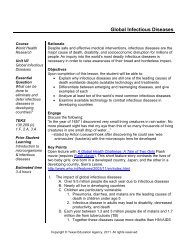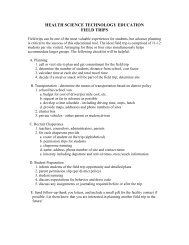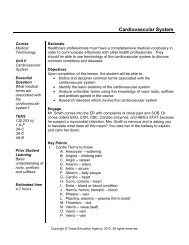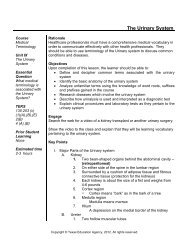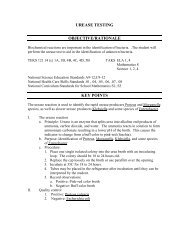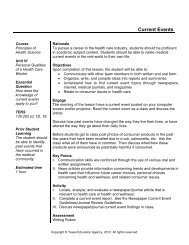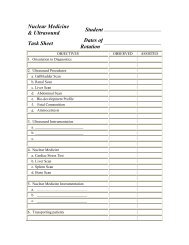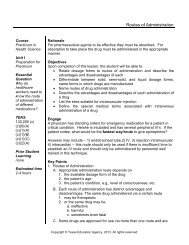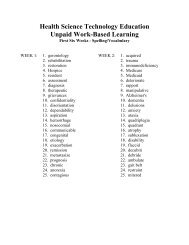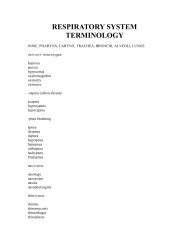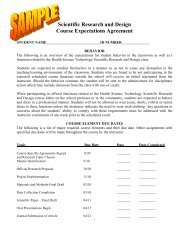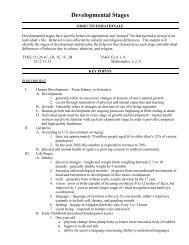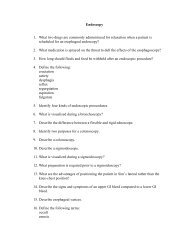Professional Liability and Medical Malpractice - Health Science ...
Professional Liability and Medical Malpractice - Health Science ...
Professional Liability and Medical Malpractice - Health Science ...
You also want an ePaper? Increase the reach of your titles
YUMPU automatically turns print PDFs into web optimized ePapers that Google loves.
<strong>Professional</strong> <strong>Liability</strong> <strong>and</strong> <strong>Medical</strong> <strong>Malpractice</strong><br />
Course<br />
Practicum in<br />
<strong>Health</strong> <strong>Science</strong><br />
Unit IV<br />
Ethical <strong>and</strong><br />
Legal<br />
Responsibilities<br />
Essential<br />
Question<br />
What are the<br />
ethical, moral,<br />
<strong>and</strong> legal<br />
st<strong>and</strong>ards<br />
expected of<br />
healthcare<br />
workers in<br />
today’s society?<br />
TEKS<br />
130.205 4(A),<br />
4(C)<br />
Prior Student<br />
Learning<br />
Client Autonomy<br />
Patient’s Rights<br />
Estimated time<br />
2 – 4 hours<br />
Rationale<br />
The health science student needs to know ethical behavior st<strong>and</strong>ards <strong>and</strong><br />
legal responsibilities.<br />
Objectives<br />
Upon completion of the this lesson, the student will be able to:<br />
• Identify legal terms utilized in healthcare<br />
• Correlate how professional liability, privacy, confidentiality, <strong>and</strong> the<br />
elements of negligence relate to court cases on medical ethics <strong>and</strong><br />
st<strong>and</strong>ards of care<br />
Engage<br />
Define <strong>Professional</strong> <strong>Liability</strong> <strong>and</strong> <strong>Medical</strong> <strong>Malpractice</strong>. Discuss the possible<br />
causes of malpractice, recent cases in the news media, <strong>and</strong> the<br />
responsibilities of a healthcare provider.<br />
Key Points<br />
I. Competent adults are liable, or legally responsible, for their own acts,<br />
both on the job <strong>and</strong> in their private lives.<br />
A. Employers are liable for their employees in regards to<br />
1. Building <strong>and</strong> grounds – adequate upkeep to prevent injury<br />
2. Automobiles – if an employee uses their own car or their<br />
employer’s car, the employer must be adequately insured in<br />
case of an accident.<br />
3. Employee safety – a comfortable <strong>and</strong> safe work environment<br />
II. As professionals we are responsible for our actions (or failure to act)<br />
under a reasonable st<strong>and</strong>ard known as the St<strong>and</strong>ard of Care.<br />
A. <strong>Professional</strong>s are held to a higher st<strong>and</strong>ard <strong>and</strong> may be held liable<br />
for negligence.<br />
B. <strong>Health</strong>care workers must be careful in the duties they perform; if<br />
they perform duties commonly assigned to those with a higher level<br />
of training <strong>and</strong> expertise, they may legally be held to a higher<br />
st<strong>and</strong>ard of care.<br />
III. Privacy, Confidentiality, <strong>and</strong> Privileged Communication<br />
A. It is a healthcare professional’s ethical <strong>and</strong> legal duty to safeguard<br />
a patient’s privacy.<br />
B. Confidentiality is the act of holding in confidence information that is<br />
not to be released to unauthorized individuals.<br />
C. Privileged communication is information held confidential within a<br />
protected relationship.<br />
D. <strong>Medical</strong> office confidentiality should be maintained:<br />
Copyright © Texas Education Agency, 2012. All rights reserved.
1. Do not release information to a third party without a signed<br />
consent.<br />
a. When talking on the phone regarding test results, be<br />
sure no one else can hear.<br />
b. When leaving a message on an answering machine, just<br />
tell the patient to call the office regarding their recent<br />
appointment.<br />
2. Do not decide confidentiality on the basis of your personal<br />
approval of the thoughts <strong>and</strong> actions of the patient.<br />
E. Confidentiality may be waived<br />
1. If the patient sues the physician for malpractice<br />
2. If the patient signs a waiver to release information<br />
IV. Tort of Negligence<br />
A. Unintentional tort of negligence is the basis for malpractice claims<br />
1. Tort is a civil wrong committed against a person or property,<br />
excluding a breach of contract.<br />
2. Negligence is an unintentional tort alleged when one may<br />
have performed or failed to perform an act that a reasonable<br />
person would or would not have done under similar<br />
circumstances.<br />
B. <strong>Medical</strong> professional liability claims are classified in three ways:<br />
1. Malfeasance – a performance of a totally wrongful <strong>and</strong><br />
unlawful act<br />
2. Misfeasance – a performance of a lawful act in an illegal or<br />
improper manner<br />
3. Nonfeasance – a failure to act when one should have<br />
C. The four elements that must be present to prove a healthcare<br />
professional is guilty of negligence:<br />
1. Duty – a person charged with negligence owed the duty of<br />
care to the victim.<br />
2. Derelict – a healthcare provider breached (failed to comply)<br />
the duty of care to the patient.<br />
3. Direct Cause – a breach of duty was the direct cause of the<br />
patient’s injury<br />
4. Damages – monetary awards sought by the plaintiffs<br />
(patients) in the lawsuit where there is a legally recognizable<br />
injury to a person<br />
V. Elements of a Lawsuit<br />
A. A patient feels he or she has been injured.<br />
B. A patient seeks the advice of an attorney.<br />
C. The attorney believes the case has merit, <strong>and</strong> requests copies of<br />
patient’s medical records.<br />
D. Pleading Phase<br />
1. The patient’s attorney files a complaint with the court.<br />
Copyright © Texas Education Agency, 2012. All rights reserved.
2. A summons is issued by the court, <strong>and</strong> is delivered to the<br />
defendant.<br />
3. The defendant’s attorney files an answer to the summons.<br />
4. A cross complaint is made <strong>and</strong> the patient files a reply.<br />
E. Interrogatory or Pretrial Discovery Phase<br />
1. The trial date is set by the court.<br />
2. Pretrial motions may be made, such as a dismissal or<br />
amendment of the original complaint.<br />
3. A court order (subpoena) is issued requiring that a deposition<br />
(sworn testimony) be taken from a medical office employee.<br />
[Someone] may request an interrogatory, which is a written set<br />
of questions requiring written answers.<br />
4. A pretrial conference with the judge, where attorneys discuss<br />
the issues in the case<br />
F. Trial Phase<br />
1. Jury selection<br />
2. Opening statements by both attorneys<br />
3. Witnesses take the st<strong>and</strong><br />
4. Closing statements by both attorneys<br />
5. The jury’s verdict<br />
6. The final judgment is h<strong>and</strong>ed down by the court<br />
G. Appeals Phase<br />
1. Post-trial motions are filed.<br />
2. Appeal the case to a higher court.<br />
H. Nine out of ten lawsuits are settled out of court, but many times<br />
healthcare practitioners are asked to give testimony. There are two<br />
kinds of testimony:<br />
1. Fact – these are only the actual facts the witness has<br />
observed.<br />
2. Expert – must have relevant education, skills, knowledge, <strong>and</strong><br />
experience in order to be judged as an expert in the trial.<br />
VI. Alternative Dispute Resolution<br />
A. As court calendars become overcrowded, alternative dispute<br />
resolution has become increasingly popular. Alternative Dispute<br />
Resolution consists of techniques for resolving civil disputes without<br />
going to court.<br />
B. Methods used are arbitration <strong>and</strong> mediation:<br />
1. Arbitration is a method of settling disputes where both parties<br />
abide by the decision of an arbitrator <strong>and</strong> the arbitrator is<br />
selected directly by both parties.<br />
2. Mediation is a method in which a neutral third party listens to<br />
both sides <strong>and</strong> resolves the dispute. The mediator does not<br />
have authority to impose a solution.<br />
Copyright © Texas Education Agency, 2012. All rights reserved.
Activity<br />
I. Student groups use the court case packet <strong>and</strong> identify if the court case<br />
involved liability, st<strong>and</strong>ard of care, privacy, confidentiality, privileged<br />
communication, negligence, or a combination of these. Present to class<br />
for discussion.<br />
Assessment<br />
Successful completion of Court Case Packet<br />
Test on <strong>Professional</strong> <strong>Liability</strong> <strong>and</strong> <strong>Medical</strong> <strong>Malpractice</strong><br />
Materials<br />
Court Case Packet<br />
Key for Test on <strong>Professional</strong> <strong>Liability</strong> <strong>and</strong> <strong>Malpractice</strong><br />
Internet Websites:<br />
• American <strong>Health</strong> Information Management Association (www.ahima.org)<br />
• Physician’s Committee for Responsible Medicine (www.pcrm.org/)<br />
• American Arbitration Association (www.adr.org)<br />
Law <strong>and</strong> Ethics for <strong>Medical</strong> Careers, by Karen Judson <strong>and</strong> Sharon Hicks,<br />
CMA<br />
<strong>Medical</strong> Law <strong>and</strong> Ethics, by Bonnie Fremgen, Prentice Hall<br />
Accommodations for Learning Differences<br />
For reinforcement, the student will watch a Court TV program on medical<br />
malpractice, <strong>and</strong> write a documentation of events.<br />
For enrichment, the student will use Internet web sites <strong>and</strong> identify sources<br />
that might be used by laypersons to check the credentials <strong>and</strong> malpractice<br />
records of physicians.<br />
National <strong>and</strong> State Education St<strong>and</strong>ards<br />
National <strong>Health</strong> <strong>Science</strong> Cluster St<strong>and</strong>ards<br />
HLC02.01 Communications<br />
<strong>Health</strong> care workers will know the various methods of giving <strong>and</strong> obtaining<br />
information. They will communicate effectively, both orally <strong>and</strong> in writing.<br />
HLC04.01 Information Technology Applications<br />
<strong>Health</strong> care workers will use information technology applications required<br />
within all career specialties. They will demonstrate use as appropriate to<br />
health care applications.<br />
HLC08.01 Ethics <strong>and</strong> Legal Responsibilities<br />
<strong>Health</strong> care workers will underst<strong>and</strong> the legal responsibilities, limitations, <strong>and</strong><br />
implications of their actions within the health care delivery setting.<br />
HLC08.02 Ethics <strong>and</strong> Legal Responsibilities<br />
Copyright © Texas Education Agency, 2012. All rights reserved.
<strong>Health</strong> care workers will underst<strong>and</strong> accepted ethical practices with respect<br />
to cultural, social, <strong>and</strong> ethnic differences within the health care environment.<br />
They will perform quality health care delivery.<br />
TEKS<br />
130.205(c)(4)(A) appraise individual ethical <strong>and</strong> legal behavior st<strong>and</strong>ards<br />
according to professional regulatory agencies; <strong>and</strong><br />
130.205(c)(4)(C) critique court cases related to professional liability <strong>and</strong><br />
ethics.<br />
Texas College <strong>and</strong> Career Readiness St<strong>and</strong>ards<br />
Cross-Disciplinary St<strong>and</strong>ards:<br />
I.A.1 Engage in scholarly inquiry <strong>and</strong> dialogue<br />
I.A.2 Accept constructive criticism <strong>and</strong> revise personal views when valid<br />
evidence warrants<br />
I.B.1 Consider arguments <strong>and</strong> conclusions of self <strong>and</strong> others<br />
I.B.2 Construct well-reasoned arguments to explain phenomena, validate<br />
conjectures, or support positions<br />
I.B.3 Gather evidence to support arguments, findings, or lines of reasoning<br />
II.A.4 Identify the key information <strong>and</strong> supporting details<br />
Social Studies St<strong>and</strong>ards:<br />
I.E.4 Identify <strong>and</strong> evaluate the sources <strong>and</strong> consequences of social conflict<br />
I.F.2 Analyze ethical issues in historical, cultural, <strong>and</strong> social contexts<br />
IV.A.3 Evaluate sources from multiple perspectives<br />
English/Language Arts St<strong>and</strong>ards:<br />
II.A.5 Analyze the presentation of information <strong>and</strong> the strength <strong>and</strong> quality of<br />
evidence used by the author, <strong>and</strong> judge the coherence <strong>and</strong> logic of the<br />
presentation <strong>and</strong> the credibility of an argument<br />
III.B.2 Participate actively <strong>and</strong> effectively in group discussions<br />
Copyright © Texas Education Agency, 2012. All rights reserved.
Test – <strong>Professional</strong> <strong>Liability</strong> <strong>and</strong> <strong>Medical</strong> <strong>Malpractice</strong><br />
Damages Negligence <strong>Liability</strong><br />
Tort Confidentiality Malfeasance<br />
Breach Nonfeasance St<strong>and</strong>ards of Care<br />
Misfeasance<br />
1. ___________________ is the act of holding in confidence information that is not to be<br />
released to unauthorized individuals.<br />
2. Being legally responsible for your own actions is called ___________________.<br />
3. ___________________ is performance of a totally wrongful <strong>and</strong> unlawful act.<br />
4. ___________________ is a civil wrong committed against a person or property, excluding<br />
breach of contract.<br />
5. Failure to comply is called ______________________.<br />
6. ___________________ is failure to act when one should.<br />
7. Being responsible for our actions (or failure to act) under a responsible st<strong>and</strong>ard is<br />
___________________.<br />
8. Monetary awards sought by the plaintiff are ____________________.<br />
9. ___________________ is performance of a lawful act in an illegal or improper manner.<br />
10. ___________________ is an unintentional tort alleged when one may have performed or<br />
failed to perform an act that a reasonable person would or would not do under similar<br />
circumstances.<br />
Use your critical thinking skills to answer the questions that follow each of the case<br />
studies.<br />
11. A trainee anesthesiologist ran out of oxygen before the operation was completed, causing<br />
the patient to suffer a fatal cardiac arrest.<br />
This case was adjucated as a strong medical malpractice case <strong>and</strong> was won by the plaintiff.<br />
Referring to the four Ds of negligence, explain why.<br />
Copyright © Texas Education Agency, 2012. All rights reserved.
12. During an endoscopic retrograde cholangiopancreatography (ERCP), an inexperienced<br />
nurse injected the dye too forcefully <strong>and</strong> caused the patient to develop pancreatitis <strong>and</strong> other<br />
debilitating injuries.<br />
The patient sued <strong>and</strong> won. Refer to the four Ds of negligence to explain the court’s decision.<br />
13. An on-call ophthalmologist, without seeing the patient, diagnosed his eye pain, sensitivity to<br />
light, <strong>and</strong> nausea as sinusitis. In fact, the patient had acute angle closure glaucoma, <strong>and</strong><br />
lost sight in the eye.<br />
When this case came to trial, the court found in favor of the patient/plaintiff. Explain the<br />
court’s decision based on the four Ds of negligence.<br />
Copyright © Texas Education Agency, 2012. All rights reserved.
<strong>Professional</strong> <strong>Liability</strong> <strong>and</strong> <strong>Medical</strong> <strong>Malpractice</strong><br />
KEY<br />
1. Confidentiality<br />
2. <strong>Liability</strong><br />
3. Malfeasance<br />
4. Tort<br />
5. Breach<br />
6. Nonfeasance<br />
7. St<strong>and</strong>ard of Care<br />
8. Damages<br />
9. Misfeasance<br />
10. Negligence<br />
11. The anesthetist owed the patient duty of care that was breached by (direct cause) failing to<br />
make sure there was sufficient O 2 for the procedure. There was a legally recognized injury<br />
to the patient.<br />
12. The nurse owed the patient duty of cause that was breached when she used an improper<br />
technique in performing a procedure within the scope of her duties. The patient suffered an<br />
injury that influenced the court’s decision.<br />
13. The physician established duty of care to the patient by diagnosing over the phone. That<br />
duty breached the physician’s failure to conduct a physical exam, which led to a<br />
misdiagnosis. The patient suffered a recognized injury.<br />
Copyright © Texas Education Agency, 2012. All rights reserved.
Court Cases<br />
Minor’s Informed Consent Not Necessary<br />
A Texas Physician was sued for failing to secure informed consent from a minor patient before<br />
performing an abortion.<br />
In 1974 a 16-year-old girl’s mother told her physician that her daughter was retarded <strong>and</strong> had<br />
been raped. The mother gave her written permission for her minor child to have an abortion,<br />
which the physician performed. The physician did not know that in reality the girl was not<br />
retarded <strong>and</strong> had not been raped. She had conceived the child with her boyfriend.<br />
Sixteen years later the patient examined her medical records <strong>and</strong> realized that she had<br />
undergone an abortion. She sued the physician, claiming that she had not given informed<br />
consent for the procedure. In 1974 Texas did not require that a minor give informed consent for<br />
the procedure. Since the physician had obtained informed consent from a parent, as required<br />
by law at that time, a trial court held, <strong>and</strong> an appeals court affirmed, that he was entitled to<br />
summary judgment.<br />
Powers v. WF Floyd. 904 SW2d 713 (Texas Ct. of App. May 10, 1995. rehearing overruled May<br />
24, 1995)<br />
Minor Says No to Surgery<br />
Believing they were acting in the best interests of a minor, a county health department in New<br />
York State tried to obtain the court’s permission to seek surgery for a 14-year-old boy who had a<br />
cleft palate <strong>and</strong> upper lip (also called a harelip).<br />
The boy’s father would not consent to surgery for his son because he believed that forces in the<br />
universe would heal all ailments. Influenced by his father, the boy refused the offer of surgery<br />
for his condition.<br />
The court ruled that the boy could not be forced to have surgery. He could turn down the<br />
procedure because his cooperation would be needed for the speech therapy that would follow.<br />
A majority of the judges saw less harm in letting him wait until he was an adult <strong>and</strong> could make<br />
the choice for himself, than in pursuing the surgery.<br />
In the Matter of S. 309 NY 80 127 NE 2d 820 (1955)<br />
Copyright © Texas Education Agency, 2012. All rights reserved.
Physician Sued for Ab<strong>and</strong>onment<br />
A patient entered the emergency room of a hospital complaining of rectal bleeding, <strong>and</strong> was<br />
admitted as a patient of her regular attending physician. Two diagnostic procedures were<br />
completed <strong>and</strong> three more were scheduled. The patient refused to sign consent forms for the<br />
three procedures, saying she didn’t want to be anesthetized. Her physician discussed these<br />
concerns with the patient <strong>and</strong> told her to sign the consent forms or sign herself out of the<br />
hospital. The physician told the patient he would release her from his services. At that time, the<br />
patient was given a list of other physicians she could contact. The patient selected another<br />
physician <strong>and</strong> discharged herself from the hospital. The patient charged the original physician<br />
with ab<strong>and</strong>onment.<br />
A superior court entered summary judgment for the physician. The case was appealed by the<br />
plaintiff, but the appeals court held that the physician was not guilty of ab<strong>and</strong>onment. Supplying<br />
the patient, who was not in need of immediate attention, with a list of substitute physicians to<br />
replace the attending physician was a reasonable means of serving the professional relationship<br />
between a patient <strong>and</strong> an attending physician.<br />
Miller v. Greater Southeast Community Hospital. 508 A2d 927 (DC Ct. App 1986)<br />
Physician Sued for Breach of Contract<br />
A Minnesota appellate court ruled that a patient had a breach-of-contract claim against a<br />
physician who had published pictures of her without her consent.<br />
The physician performed outpatient, same-day surgery on the patient’s chin <strong>and</strong> nose, <strong>and</strong><br />
photographed her before <strong>and</strong> after surgery. The medical center later published the photographs<br />
in a brochure. The patient was not identified.<br />
The patient filed suit against the physician <strong>and</strong> medical center for invasion of privacy,<br />
international infliction of emotional distress, <strong>and</strong> violation of the Patient’s Bill of Rights. She also<br />
alleged the breach of an implied contract by the physician.<br />
On appeal, the court ruled that the patient had only a cause of action for breach of implied<br />
contract.<br />
Stubbs v. North Memorial Center 448 N.W.2d 78 (Minn Ct. of App. Nov 14 1989)<br />
Copyright © Texas Education Agency, 2012. All rights reserved.
Upset or Incompetent?<br />
Emotional upsets do not necessarily make a patient incompetent to consent to medical<br />
treatment. During a fight with his son, a Seattle man felt chest discomfort <strong>and</strong> thought he was<br />
having a heart attack. At the hospital, he was given four drugs, including a narcotic pain<br />
medication. The suspected heart attack was diagnosed as a muscle strain, but while he was<br />
hospitalized the man agreed to surgery on his nose. The nose surgery turned out bad, <strong>and</strong> the<br />
man sued, claiming that he had been in a drug-induced state <strong>and</strong> could not make an intelligent<br />
decision about having the nose surgery. If he had not been competent, then the man had not<br />
actually consented to the surgery <strong>and</strong> the surgeon committed assault.<br />
A judge dismissed the case. The law presumed that the patient in this case had been<br />
competent because a legally competent person is one who can underst<strong>and</strong> his or her illness,<br />
the proposed treatment, <strong>and</strong> the risks in either accepting or refusing it. The patient met these<br />
criteria.<br />
Grannum v. Berard 70 Wash 2d 304 422 P2d 812 (1967) annot. 25 A.L.R. 3d 1443<br />
No Breach of Contract by a Radiologist<br />
A Georgia appellate court ruled that a patient’s claim that a radiologist breached an express<br />
warranty had been properly dismissed by a lower court.<br />
The radiologist performed an arteriogram procedure which allegedly caused permanent injuries<br />
to the patient. The patient sued the radiologist for medical malpractice <strong>and</strong> breach of an<br />
express contract that he would not suffer any ill effects. The patient argued that the radiologist<br />
had stated the procedure would be routine <strong>and</strong> that he had nothing to worry about.<br />
Affirming the dismissal of the claim based on breach of contract, the appellate court said the<br />
radiologist had not expressly warranted that the patient would suffer no ill effects.<br />
Servias v. Philbrick 380 S.E.2d 496 (Ga. Ct. of App. March 10, 1989 rehearing denied. March<br />
22, 1989. Ga. Sup. Ct. May 4, 1989)<br />
Copyright © Texas Education Agency, 2012. All rights reserved.



